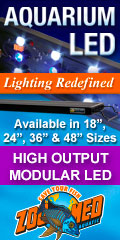375: Negatives of Scrubber:
1. You have to build it yourself (at least currently).
2. Will eventually starve xenia and other fuge macros, unless you start massively overfeeding your tank.
3. Must be cleaned weekly (one half of screen), or results will start declining.
4. Takes up room.
5. Uses power (if pump powered).
cvermeulen:
All you are **really** doing by setting up this algae screen is using the algae as a denitrator
You are also using it for:
Inorganic Phosphate removal
Metals removal
CO2 removal
Oxygen additions
Pods additions
Cooling
I don't know where the nitrogen goes, but I'd hazard it either gets off-gassed or gets used in the synthesis of bio mass
Correct, bio mass.
If you then take that bio mass and feed it to your pleco in the same system, the cycle begins again
Yes but remember many of the organisms/animals in our tanks are already fully grown (hermits, for example), so in these cases the amount of N put into their bodies equals the amount of N leaving their bodies. They are not absorbing anything. Thus something else has to get N out of the tank.
Maybe you saw the half-pound (wet) of algae I removed last week; I could feed all the fish for a week using only one-tenth of that.
I'm really trying to avoid much more water to air exposure in my setup
Then use a box or bucket, and put a lid on it. Evaporation will stop.
or plexi, whatever I can find)
Do use screen, not plexi.
submerged about 1/2" in the refugium, positioned by the refugium overflow so all the circulating water has to pass over the screen.
Keep it just above the waterline, instead of below it. Have the overflow splash down on it.
I'll just put a pair of CF spotlights on it, about 3" from the water's surface and run them 24/7.
24 hours for a week, then switch to 18 on, 6 off.
nfored:
Wouldn't it be much nicer looking to just have your water cycling through a plant filter? That is exactly what this is a plant filter, but with unsightly algae instead of plants.
You are refering to a refugium. Scrubbers are different from a fuge in so many ways:
o Light: There is very little water standing in the way of the light. Also, the light is (or should be) very close to the scrubber... 4" or less. The power of light varies with the square of the distance, so going from 8" to 4" actually gives you 4X the power, not 2X. And the nutrient removal power of algae is proportional to the power of the light, because it's the photosynthesis that is doing the processing.
o Rapid flow: More delivery of nutrients to the scrubber.
o Turbulence: Helps removes the boundary layer of water around the algae. This boundary layer slows the transfer of metabolites in and out of the algae.
o Pulsed Flow: The option of being able to pulse the flow (and use a fan) REALLY helps get rid of the boundary layer of water, and also helps kill the green hair and brown slime that tend to cover up real turf (although green hair and brown slime still do lots of filtering). This is how turf algae grows on the beach, with wind and waves.
o Surface Area: When you clean/scrape a screen, the surface area is not reduced like it is with fuge macros or plants.
o Traps no waste/food like a refugium or DSB does; waste/food flows right past the screen.
o Does not release strands into display, like chaeto.
o Does not go sexual, like caulerpa can.
o Is 1/2 or 1/3 the physical size, for the same processing power.
o Weighs nothing (holds no water), so can be set on regular furniture.
o Cools the water. And if a fan is used, it REALLY cools the water.
o Does not ever produce hydrogen sulfide (rotten eggs), like DSBs or denitrators can.
o Can be set on top of the tank, so pods drain right into tank.
o Is free.
o Is portable.
o Can run two, for backup, in the same space as one fuge.
o Will oxygenate the tank if main return pump goes out, if the scrubber drains into the display.















